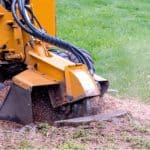Last updated on March 27th, 2022
Our site is reader supported, this means we may earn a small commission from Amazon and other affiliates when you buy through links on our site.
Leaf mould is the result of decaying leaves, something you can use to condition your soil, use as mulch, and even mixed 50/50 with compost to use in containers if its good well-rotted leaf mould that is at least 2 years old.
All leaves and needles will break down eventually into leaf mould. However, you should be aware of what trees you have and decide from there how you might aid the breakdown process because each tree is different and some leaves are simply best shredded and used as leaf mould or added to a compost bin instead if the leaves break down much more slowly.
The Types of Leaves that work best for making leaf mould
Oak leaves, beech, and hornbeam leaves need a bit of help in order to produce a high-quality leaf mould. Thicker leaves, such as chestnut leaves or walnut leaves might need to be shredded before you add them to any compost pile. Evergreens shrubs like Holly also need to be shredded before you add them to the pile.
It can take between 2 and 3 years for conifer needles to break down and decay, so it is best that you clip them yourself beforehand to expedite the process. Pine needles, however, will make a more acidic leaf mould that is perfect for gardeners with ericaceous plants like Blueberries, Rhododendrons, or Azaleas.
When to Make Leaf mould
Start collecting leaves in autumn
Most deciduous trees drop their leaves in autumn which, incidentally, is the best time to start gathering material for your leaf mould pile. Pine needles are different in that they are shed all year round, so you can collect them at any time, though most prominently in spring and add them to the pile.
How to Make leaf mould
The process takes up to 2 years, consider collecting leaves with a leaf blower vacuum or mower if you are clearing your lawn of leaves
Collect leaves from your own garden or you could visit your local park in autumn and collect a few bag fulls. You can collect them with a rake, by hand, or with machinery like a rotary mower. Rotary mowers are great because they not only collect the leaves but shred them in the process which expedites the rotting process (and if you gathered them from your lawn, you benefit from the extra grass clippings in the mix).
You could also consider getting a leaf blower vacuum to collect leaves and these will also shred the leaves too.
Place all collected leaves into a black bin liner and pierce holes in the bag
Put all of your collected leaves in a bin liner and make small holes in the bag with a garden fork or knife. Tie the bags loosely and stack them somewhere they won’t be in the way, for example, behind a shed. These bags will need to be left for about 2 years, so it is good to find somewhere they won’t be seen. Some leaves will rot down in as little as 12 months but this type of leave mould is best used as a mulch or organic soil conditioner.
You can, alternatively, make a frame with chicken wire and stakes, in a sheltered area of your garden and heap the leaves there. This will also take about 2 years to complete.
Making leaf mould with a wireframe
The same way you tend to a compost pile, you can help the quality of your leaf mould pile by aerating it and turning the leaves regularly. You don’t want the leaves to dry out, so moisten them during hot spells. With all this work in mind, most people opt for simply placing leaves in black bags.
What to use leaf mould for
Once the two-year time frame is over, and the leaves have broken down, it is time to use the material. You can use it the same way you would use compost, by mixing it into your soil to add nutrients to the soil and act as a mulch.
It’s also perfect for mixing with potting compost 50/50 and using it to pot plants into containers or topping up containers.
Leaf mould that is less than two years old
If your leaf mould turned out poorly, or you don’t want to wait 2 years, you can use the mixture as you would mulch, as a top layer for your soil to help protect plants in the winter as well as suppress weeds in spring and helping to retain moisture.


